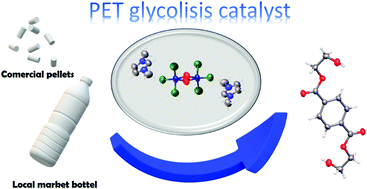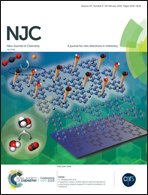Comparing conventional and microwave-assisted heating in PET degradation mediated by imidazolium-based halometallate complexes†
Abstract
The catalytic activity of two halometallate complexes based on imidazolium cations, (dimim)[FeCl4] (1) and (dimim)2[Fe2Cl6(μ-O)] (2), was evaluated in the glycolysis of polyethylene terephthalate (PET), either under conventional heating or microwave-assisted conditions. The two procedures led to the formation of bis(2-hydroxyethyl)terephthalate (BHET) as the major product with high yields, also allowing the isolation and structural characterization of a new polymorph. The influence of the halometallate structure on the catalytic activity was investigated, and additional experimental studies proved the involvement of both the imidazolium cation and metal anion in the reaction mechanism. The comparison of both approaches showed the advantages of the microwave methodology in terms of efficiency and time saving. Indeed, the use of ground PET and microwave heating provided quantitative yields of BHET. Under conventional heating conditions, the dinuclear iron complex gave a slightly lower yield than (dimim)[FeCl4] (74% vs. 77% for post-consumer PET) after 24 h of reaction. However, the microwave-assisted process led to comparable results in remarkably shorter reaction times (2 h). Interestingly, complex 2, containing the dipolar [Fe2Cl6(μ-O)]2− moiety, provided higher yields than 1 with the non-dipolar [FeCl4]− anion (77% vs. 69%). This behaviour has been rationalized on the basis of dielectric heating mechanisms (polarization and conduction), and it suggests a new approach towards obtaining more efficient catalysts by tailoring the catalytic species to be active in both heating mechanisms.



 Please wait while we load your content...
Please wait while we load your content...